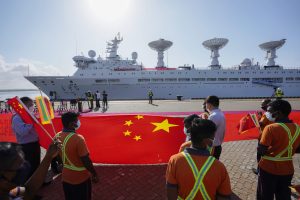In September 2019, the Indian Navy drove away the Shiyan 1, a Chinese research vessel that had been caught operating without authorization in India’s Exclusive Economic Zone (EEZ) off the coast of the Andaman and Nicobar Islands.
This move was undertaken in line with Article 246 of the United Nations Convention on the Law of the Sea (UNCLOS), which prohibits any country from conducting marine scientific research in the EEZ of a coastal state without consent. It also stipulates that such consent should be ideally granted in “normal circumstances.” But given the context – China’s research activities in the South China Sea, as well as the larger Chinese strategy of military-civil fusion, which has blurred the line between the scientific and military-related activities of its vessels – the circumstances were hardly normal.
More recently, alarms have again been sounded in India about the potential docking and port call of another Chinese “comprehensive research and survey ship,” the Xiang Yang Hong 03, in Malé, the Maldives.
The key source of concern is the ability of such a survey ship, while purportedly conducting peaceful research and maritime tracking activities in the Indian Ocean region (IOR), to map the ocean’s seabed and study maritime currents and oceanographic trends.
All this collected information can be used for military purposes. These uses can range from studying ideal seasonal deployment patterns for submarines, to gathering oceanographic data such as maximum depth for visualizing a mine warfare scenario. Similarly, continued collection of marine wind data can be utilized to extrapolate the ocean wind resources in coastal areas at given times, enabling an assessment of the enemy jets’ take-off and landing requirements, as well as those of China’s own airpower in the IOR.
Moreover, Chinese vessels have a history of “going dark,” which refers to their crew turning off the vessels’ automatic identification system transponders. This can enable the vessels to conduct military activities without being identified or located, especially in continental shelf areas that lie beyond the EEZs of coastal states.
Three years ago, around January 11, 2021, the same vessel that will soon dock in the Maldives, the Xiang Yang Hong 03, was intercepted by the Indonesian Coast Guard in its EEZ after the vessel had “gone dark.” The development came a month after an Unmanned Underwater Vehicle (UUV) resembling the Chinese Sea Wing (Haiyi) UUV was discovered close to the waters near the Indonesian coast, where there are two critical maritime chokepoints, the Sunda and Lombok straits.
It can be inferred from the timing of the Xiang Yang Hong 03 incident that once the UUV was discovered, the Chinese resorted to deploying a research vessel capable of conducting similar defense-related assessments, but with its transponders off.
Both the UUV and the vessel have capabilities to conduct surveillance of ocean features for submarine stealth planning. This can be done, for example, by assessing the level of chlorophyll in the waters; submarine stealth can be at risk if it disturbs chlorophyll.
In the past, similar Chinese research vessels have even conducted collaborative operations with Sea Wing UUVs, dispersing over a dozen similar underwater gliders in the Bay of Bengal region to conduct a continuous assessment of oceanographic data. Sea Wing UUVs were launched both in 2017 and 2019 to conduct “cooperative observation in a designated sea area.” The value of the large amount of hydrological data collected over time, including temperature, salinity, turbidity, and oxygen content, is unprecedented.
It is also important to note the military affiliations of the institutions in charge of building these vessels and supervising their operations. For example, the developer of the UUVs launched in 2017, the Chinese Academy of Sciences’ Shenyang Institute of Automation (SIA), is by name a research center dedicated to building civilian high-technology equipment. However, the Institute also engages in military equipment building, having been awarded a contract in 2020 to develop an “intelligent self-flying machinery” for the People’s Liberation Army Air Force, while also developing a classified project (Project 912) to develop military underwater robots. In 2022, SIA was also added to the United States’ Entity List for “attempting to acquire American-origin items in support of military applications.”
Similarly, the Qingdao Pilot National Lab for Marine Science and Technology, which has been deeply involved in sea voyages of the Xiang Yang Hong 03, has also collaborated with the People’s Liberation Army on various naval defense projects. Moreover, its functioning is governed, among other entities, by the China State Shipbuilding Corporation and the Qingdao Ocean University, both of which are key pillars of China’s military-civil fusion strategy, and have regularly contributed to the PLA Navy’s force-building work.
Since 2019, the activities of Chinese research vessels have overshadowed the maritime survey work being conducted by any other country’s vessels in the expansive Indian Ocean Region. Hence, from a military strategic perspective, an understanding of their operational procedures and potential dual-use applications is critical to India’s maritime security interests. It is also significant for India to make active efforts at its end to curtail the docking of such vessels in surrounding waters. In this regard, the Sri Lankan government’s January 5 decision to not permit any Chinese research ship to operate within its EEZ or dock at its ports for a year, is welcome news.
Even though New Delhi has not launched a formal protest with Malé over the potential docking of Xiang Yang Hong 03 in the coming days, the shaky relationship between the two sides in the past few months, in addition to Maldives President Mohamed Muizzu’s evident pro-China posture, may create hurdles for India’s legitimate security interests.

































